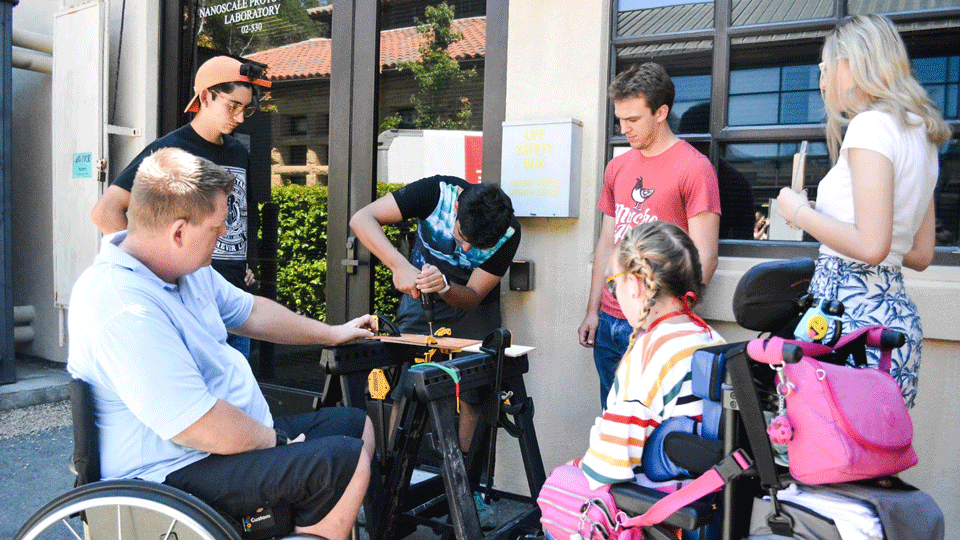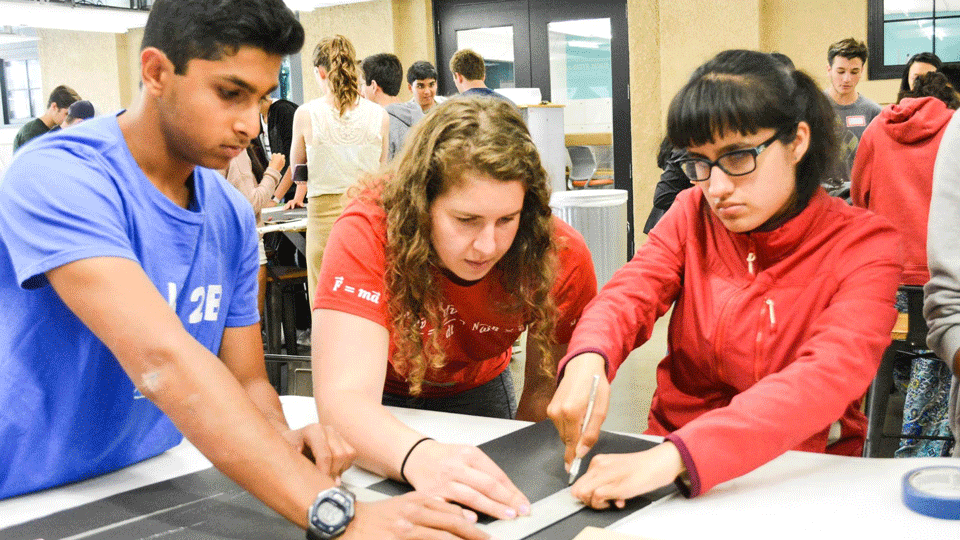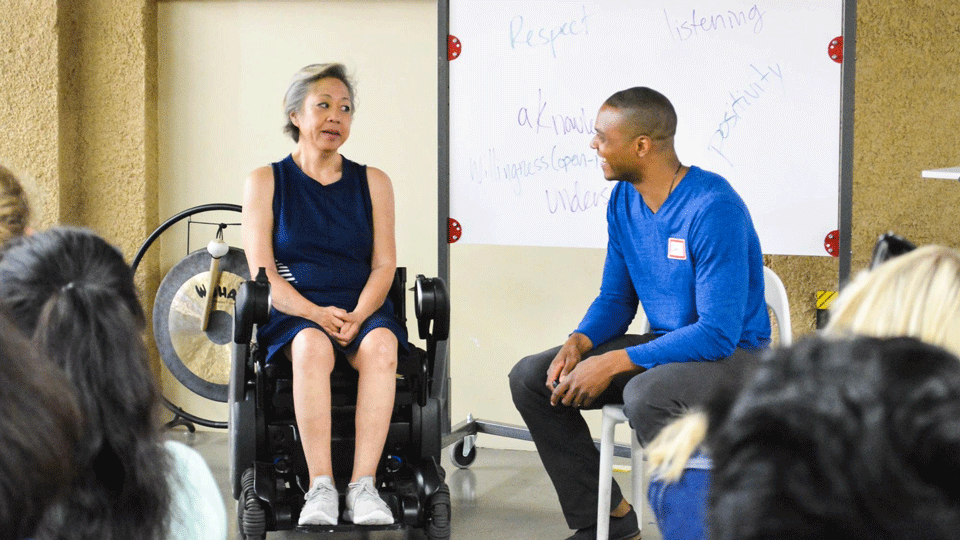 A Design the Future team prototypes their final design project.
A Design the Future team prototypes their final design project.
Jazmine was a thoughtful and curious student who worked hard to earn good grades at her San Francisco Bay Area public high school in hopes of attending college. “Being blind meant that it took me longer to complete homework assignments, especially in science and math classes,” she says. “There were times I didn’t have my [braille display or screen reading software installed] for months because the principal said it wasn’t worth spending money on. He said I probably wouldn’t graduate from high school anyway.”
He was wrong. Jazmine transferred to the California School for the Blind, which states as one of its core values that “students with visual impairments…need to be given the skills necessary to reach their highest potential academically and socially whether through high school graduation or through the acquisition of functional life skills.” Jazmine received her high school diploma in June 2018.
So how could two schools view the same student so differently? It comes down to their perspectives on people with disabilities.
One school, reflecting an exclusive design approach, saw Jazmine as a liability—as someone who didn’t have much to offer to the school environment or to society. The other school, like a good practitioner of inclusive design, saw Jazmine as an asset to its community and someone who, if given the right support, could make the world a better place.
Are you enjoying this article? Read more like this, plus SSIR's full archive of content, when you subscribe.
Most of the world is like the first school. It rarely gives people like Jazmine—those who need flexible and adaptive programs, policies, and services—the chance to contribute and affect how or why our world is structured the way it is.
 Jazmine uses an X-Acto knife to prototype a design with her team.
Jazmine uses an X-Acto knife to prototype a design with her team.
To solve this problem, we created Design the Future: a program to address the gaps in the everyday quality of life of those with disabilities and ensure they can fully participate in our society.
The weeklong program shows high school students how to design products for and in partnership with individuals with physical disabilities. It was created by the social impact design firm DC Design and developed in collaboration with the d.school, the Hasso Plattner Institute of Design at Stanford University. It involves student teams—which have in the past included Jazmine and two of her classmates—producing functional products that improve the quality of life of their project partners.
Human-centered design (HCD) is the foundation of our curriculum, but we discovered a major flaw in the popular approach to creative problem-solving: Warm up activities, brainstorming techniques, prototyping methods, and verbal and print instructions often aren't accessible to individuals with physical and sensory disabilities.
The Design the Future team—multidisciplinary educators, designers, disability advocates, and researchers—reworked the traditional design thinking process and materials with the aim of creating a program where all students could participate from start to finish. We also developed a three-tier framework for categorizing inclusive design practices and illuminating the areas where accessibility improvements are still needed.
The framework relies upon American with Disabilities Act (ADA) standards, Section 508 of the Rehabilitation Act, and the Web Content Accessibility Guidelines (WCAG) for establishing accessible and inclusive processes for students with and without disabilities.
We want everyone, regardless of physical ability, to be able to acquire the same information, engage in the same interactions, and enjoy the same services. We hope designers, educators, entrepreneurs, and community members can use this framework to improve their design processes and programs.
Tier 1: Meet Compliance Standards
Tier 1 diversity and inclusion efforts meet legal requirements or recommendations. They don’t affect the quality or efficacy of what is designed but make it possible for people with a broad range of abilities to use that design after it is developed. One example comes from the broader disability rights movement: handicapped stalls in public restrooms. They allowed millions of additional individuals to use a physical space.
 Fernanda Castelo and Durell Coleman demonstrate an empathy Interview during Design the Future.
Fernanda Castelo and Durell Coleman demonstrate an empathy Interview during Design the Future.
Your organization can use ADA guidelines to examine how your physical spaces either enable or inhibit people's participation. The WCAG guidelines will help you understand how digital assets, such as websites or documents, can better accommodate those with disabilities. We recommend familiarizing yourself with the general principles of both guidelines, creating a list of priority issues, and then searching the guidelines and the internet for guidance on the changes you want to make.
As you modify your process, consider the needs of all potential participants and prioritize the needs faced by your target audience. For example, does your program need to be more accessible to individuals with vision, hearing, motor, or cognitive disabilities? Do you need to cater to a combination of these?
As you figure out who you want to accommodate, invite people from those communities to provide feedback on the physical and digital spaces, and the planned activities. This feedback will help identify areas of exclusion and inform plans for accommodations. For websites, you can use accessibility evaluation tools such as WAVE to perform automated accessibility testing. Both digital accessibility and ADA compliance is a process that requires ongoing monitoring to ensure access.
In the case of the Design the Future curriculum, we focused on the needs of those with vision and motor difficulties, as this would meet the needs of our students from the California School for the Blind and the vast majority of our project partners, who use wheelchairs.
The changes we made to align with Tier 1 include:
-
Updating our application process and digital documents: Our application process was difficult to navigate for individuals who used screen reader and magnification software. The barrier had the potential to discourage students with disabilities from even applying to the program. Our fix? We provided one-on-one help with reading the application and entering responses. Moving forward, we’ve changed our application portal to one that is fully WCAG compliant, enabling more students to apply with ease.
-
Providing alternative formats: We provided braille and large-type versions of our printed materials and made them accessible online. This enabled students of different abilities to read about the stages of design thinking and ask well-crafted questions during team interviews.
-
Making intentional choices about physical space: In design thinking, we often encourage working while standing at high tables, a strategy to increase blood flow and promote energetic postures. But Title III of the ADA states that public spaces must be accessible to individuals with different physical needs. We opted to use shorter tables while giving the students who could stand the chance to do so through other frequent activities. The shorter tables ensured the most important team workspaces were accessible to everyone, including colleagues in wheelchairs.
Changes in this tier rely more on the designers’ awareness of barriers and often don’t require major investments. They represent the first step in the process of increasing the accessibility of your design practice for those with disabilities.
Tier 2: Go Beyond Compliance Standards
Tier 2 is about going beyond baseline compliance and making intentional choices about how your design process will function after you get people in the door. The majority of changes made to increase the accessibility of the design thinking process will occur in this tier, and should not demand a significant amount of additional time or money. Including those with disabilities to help you think through your process will help ensure your changes accurately address the barrier you’re seeking to design around.
Begin by thinking through your process as a whole and finding the points where difficulties may arise. Rearranging your schedule or tweaking your process slightly will often make it more inclusive. The pre-boarding option for airline passengers with disabilities is one example. This intentional process tweak makes flying more inclusive for those with disabilities without affecting whether flights can leave on time or meaningfully impacting the experience for other passengers.
For Design the Future, thinking through this tier included questions about:
-
How will students with vision difficulties navigate the space?
-
How will students with visual impairments and motor function-based challenges participate in activities like Post-it note brainstorming and prototyping?
-
How will we include everyone in warm-up activities that traditionally require visual cues and the ability to stand?
These are a few of the changes we made to align with Tier 2:
-
Updating training for design coaches: We recognized an opportunity to improve inclusion and outcomes for those with disabilities by teaching coaches how to better instruct and support student agency during each stage of the design thinking process. Our training now includes curriculum on a variety of teaching and learning methodologies, including an explanation of assistive technology devices, the social etiquette for interacting with individuals who are blind or who use wheelchairs, and ways to ensure all team members are able to participate. For example, design coaches were taught the importance of hand-under-hand instruction—the teacher’s hands perform the activity with the student’s hands resting on top—to offer students with visual impairments a greater sense of control.
-
Offering a tour of program facilities before the general orientation: We added a guided pre-orientation tour of the program facilities, and students with disabilities had the option to independently tour Stanford’s campus and the d.school building the day before the program commenced. By previewing the space, students with navigation challenges had the opportunity to locate important features, such as stairs and restrooms, and identify potential hazards, such as signs protruding from walls at head height. Additionally, students from the California School for the Blind previewed sections of Stanford’s campus with a tactile map and practiced relevant walking routes to increase confidence in navigating the unfamiliar space. After applying these changes the first time, we learned that conducting the tour further in advance of the program’s start would be an improvement, allowing the students more time to get comfortable navigating frequently traversed routes.
-
Rethinking “stoke” activities: These high energy warm-up activities are used at important moments in a design process to change the energy of the room or convey a specific point about design. They often require participants to transition between sitting, standing, and walking tasks. Unfortunately, many popular icebreakers and stoke activities exclude participants with sensory or motor function disabilities. As part of our Tier 2 changes, we tweaked the directions, including movement requirements, to allow more students to participate. One stoke activity that originally instructed participants to “walk around the room and make eye contact with another student” was modified to “move around the room and shake hands with another student.” This minor adjustment allowed students in wheelchairs and with visual impairments to connect and engage with their peers.
-
Loosely defining roles ahead of time but being flexible: Overcoming some accessibility challenges require us to think about the specific role that each student might be able to play during an activity. For example, during the empathy phase of the design process—when students are talking with their project partner to understand his or her needs—a student with a motor impairment might find it more challenging to take notes for the group but may be a great person to serve as the lead interviewer. This is an important aspect of creating a smooth and inclusive design process. The process leader should think through the upcoming activities and devise a set of possibilities for how those with different needs can best contribute. In no way should these roles become restrictive; they are meant to provide options to ensure everyone can participate.
-
Experimenting with new approaches of your own and documenting what works and what doesn’t. Throughout the program, we experimented with a number of new approaches that gave us insights into what to improve and where there are still gaps in technology. For example, during an ideation activity, we used rope and tape to create tactile quadrants on the whiteboard. Teams organized Post-it notes with similar themes into a quadrant with a corresponding tactile sticker. Some visually impaired students used smartphone apps to access the print information on each Post-it note, while others asked a teammate to read the content out loud. Despite our efforts, this experiment didn’t end up working very well for our visually impaired students. Additionally, while students with disabilities learned to use X-Acto knives and cut foam board under supervision, it was difficult for them to keep pace when their teams began prototyping high-fidelity solutions. While these experiments didn’t succeed in their own right, they do give us insight into where we need to try again in the future and why Tier 3 changes are so important.
Tier 3: Additional Resources Required
At Tier 3, including those with disabilities may require additional resources or the development of new technologies to alleviate access barriers to information, the environment, processes, and existing technology. These are the most challenging design changes to accommodate and implementing them may affect how much money something costs or how long it takes to complete. Examples include purchasing a product or device to alter a physical space like a ramp or elevator, buying assistive technology devices like a braille display, investing in the development of new technologies, or hiring more staff.
A medical facility that hires a Certified Deaf Interpreter to improve communication between doctors and patients who are deaf or hard-of-hearing exemplifies a Tier 3 effort because of the additional resources required to hire that new staff member.
For Design the Future, this tier included:
-
Hiring more design coaches and an intern for the duration of the program to help serve all students.
-
Spending additional time with students with vision difficulties during the week of the program in order to teach them certain skills at a slower pace. For example, to develop physical prototypes and teach prototyping methods, like how to use an X-Acto knife.
-
Hiring an accessibility specialist to alter our team training and co-develop innovations for the program.
While many of our Tier 3 changes made the program more accessible, more innovation is needed. During the program we learned that we didn’t have a clear way for enabling those with visual impairments to safely locate the edge of an X-Acto knife, independently and consistently access hand-written information on a Post-it note, or use visual modeling and CAD software the same way other students could. Making these activities possible will likely require the development of new technologies that reduce the gap between those with disabilities and those without. Identifying and making advancements of this kind is also, not coincidentally, why Design the Future exists—to address the gaps in the everyday quality of life of those with disabilities and ensure they can fully participate in our society.
Of course, inclusive design is more than a set of checklists; it is an approach that can help connect humans across the globe. Increasing the representation of those typically excluded from the design process will aid in identifying and solving problems that those who haven’t experienced them have a hard time identifying or understanding. We hope that inclusive design, with time, will become the default design.
Support SSIR’s coverage of cross-sector solutions to global challenges.
Help us further the reach of innovative ideas. Donate today.
Read more stories by Durell Coleman & Marie Trudelle.

